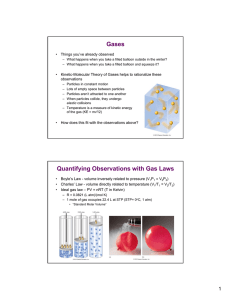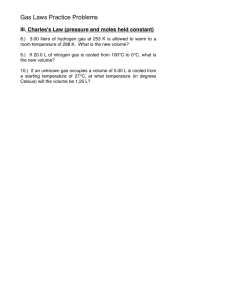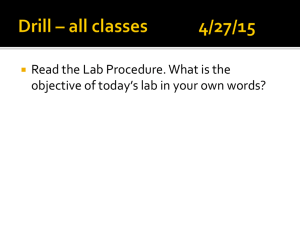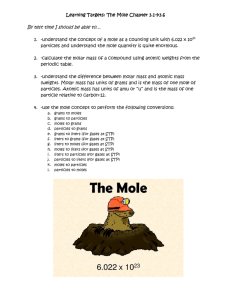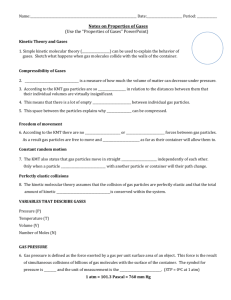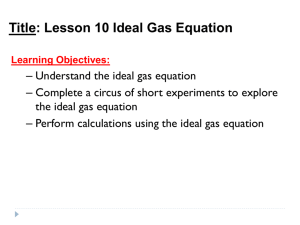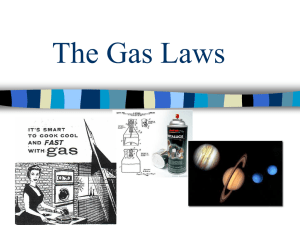Chapter 13-Gases —Average force exerted per unit area when
advertisement
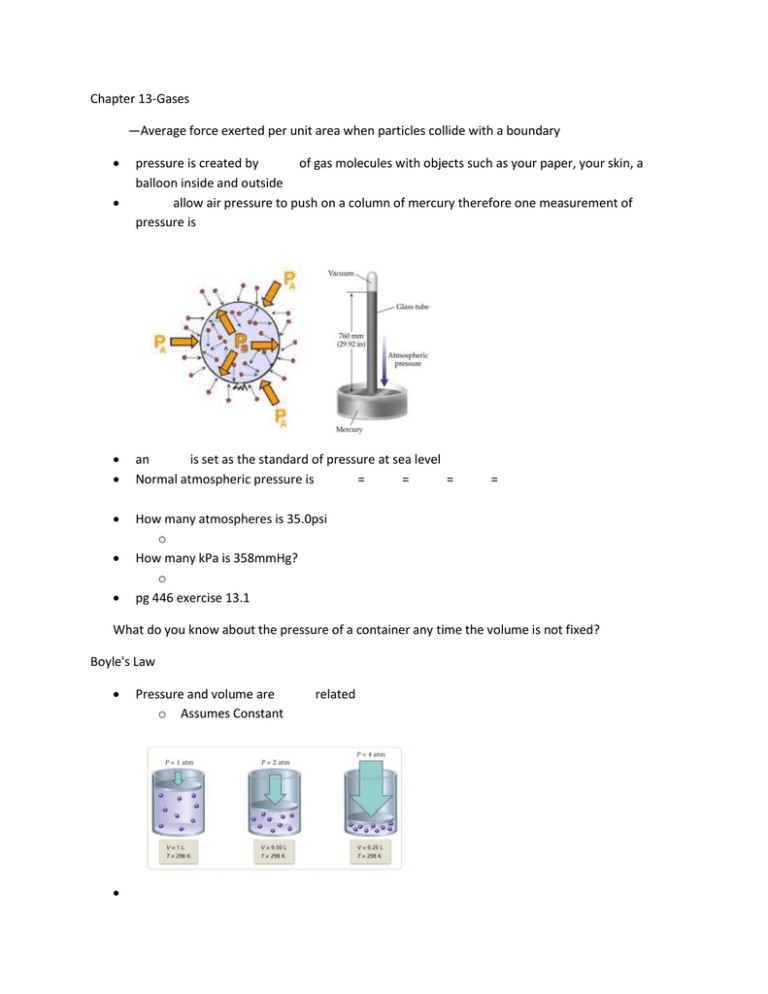
Chapter 13-Gases —Average force exerted per unit area when particles collide with a boundary pressure is created by of gas molecules with objects such as your paper, your skin, a balloon inside and outside allow air pressure to push on a column of mercury therefore one measurement of pressure is an is set as the standard of pressure at sea level Normal atmospheric pressure is = = = How many atmospheres is 35.0psi o How many kPa is 358mmHg? o pg 446 exercise 13.1 = What do you know about the pressure of a container any time the volume is not fixed? Boyle's Law Pressure and volume are o Assumes Constant related o k is a constant = A given sample of gas occupies 523mL at 1.00atm. The pressure is increased to 1.97atm, while the temperature is constant. What is the new volume of the gas? o Example 13.3 pg 410 Charles's Law Temperature and volume are o Assumes constant o Temperature must be in =𝑘 = related at constant pressure A balloon is inflated to 665mL at 27°C. It is immersed in a dry ice bath at -78.5°C. What ?is the new volume of the balloon? o Example 13.6 pg 415 Charles's Law As we cool gases, eventually they and become liquids therefore Charles's law no longer applies If we were to take those relationships and extrapolate them backwards, they would all at the same point What is this temperature? Homework: pg 480 (1, 2, 4, 7, 9, 15, 16) Avogadro's Law How does the volume respond when more moles of a gas are added? o Moles of a gas and volume are related o assumes constant and =𝑎 = Example 13.7 pg 418 Exercise 13.4 pg 419 Ideal Gas Law gas—a gas which perfectly obeys the kinetic molecular theory and therefore functions perfectly within the other gas laws. Relates the other 4 gas laws for a given gas o R is a proportionality constant which relates the 4 other units o L atm/mol K o Units used in the ideal gas law must match the units in the ideal gas constant Example 13.8, 13.9 Exercise 13.5, 13.6 If more than 2 conditions are changing Solve the ideal gas law for R o Since R is a constant then if conditions are changing o 𝑅= = Cancel out variables which are not changing Example 13.10, 13.11 Exercise 13.7, 13.8 Homework: pg 481 (19, 20, 25-30) Gas Law Decision Table Pressure Is the variable changing? Volume Moles Temperature Boyle’s Law Charles’ Law Avogadro’s Law Ideal Gas Law Combined Gas Law Homework: Worksheet Dalton's Law of Partial Pressures The pressure of a mixture of gases is equal to the of the partial pressures of each gas o = + + … Example 13.12 Exercise 13.9 If hydrogen gas is collected over water (meaning as it is produced it is bubbled through water to capture it on top of the water) and the pressure of the gases inside the container is 435.0mmHg at 25°C, what is the partial pressure of hydrogen collected The vapor pressure of water at 25°C is 23.8mmHg o o o o o What other gas is collected along with the hydrogen? (Hint: what is it in the container with?) = + What is the pressure of the water at 25°C? Gases are defined by the Molecular Theory (KMT) which states that all particles are in motion Gas molecules occupy no o Gases consist of tiny o The particles are separated by vast amounts of empty Gas molecules exert no on each other o Because they are so far apart, there are no significant forces of between the particles Average kinetic energy of the particles is directly proportional to temperature o As the temperature , they move faster o The particles move at random with high velocities, colliding with the walls of a container causing No gas is actually ideal but gases behave more ?ideally under certain conditions o temperatures-Why would this be more ideal? o Pressures-Why would this be more ideal? Explain the following using the kinetic molecular theory o What happens to pressure as volume increases? o What happens to pressure as number of moles increases? o What happens to volume as temperature decreases? o What happens to pressure as temperature increases? Homework: pg 481 (21, 33-35, 48-54 ) Gas Stoichiometry Standard Temperature and Pressure (STP) o and o Why would we need this? Molar Volume o The volume of 1 mole of any gas at STP o o This is referred to as the molar volume. o One mole of any gas at STP is Example 13.6 pg 434 Example 13.7 pg 435 Exercise 13.12 pg 435 Homework: pg 482 (37, 43-45) If conditions are not at STP, first use stoichiometry to convert to moles of gas then use to find volume at the actual conditions. How many liters of hydrogen gas will be produced at 280.0K and 96.0kPa if 1.74 moles of sodium reacts with excess water in a single displacement reaction? o o o o How many liters of water can be made from 55 grams of oxygen gas and an excess of hydrogen at a pressure of 12.4 atm and a temperature of 850°C? o How many liters of water can be made from 34 grams of oxygen gas and 6.0 grams of hydrogen gas at STP? o What is the limiting reactant for this reaction? Homework: Worksheet


